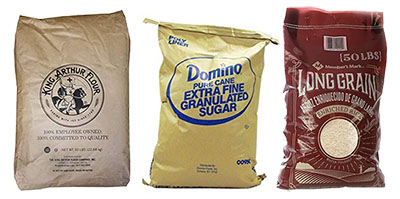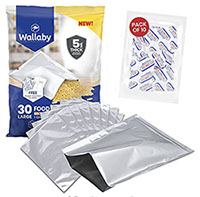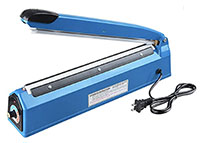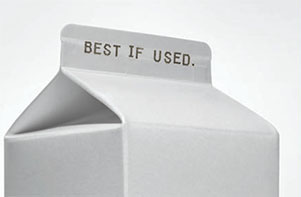This page contains affiliate links which support SalvageFood.org, a 501(c)(3) nonprofit, if you make a purchase.
How to Repackage Bulk Food for Storage
Unless you have a very large family, you won't be able to use a 50-pound bag of rice or oats before it spoils. It's important to store your bulk foods properly so they don't go bad before you can use them.
Mylar bags are the best way to store bulk food because they protect the food from light, moisture, and oxygen — especially when oxygen absorbers are used within the sealed bags. Mylar is also puncture resistant and can store certain foods for up to 30 years.
What is Mylar?
Mylar, also known as BoPET (Biaxially-oriented polyethylene terephthalate) is a polyester film made from stretched polyethylene terephthalate (PET). Mylar is used for its high tensile strength, chemical and dimensional stability, transparency, reflectivity, gas and aroma barrier properties, and electrical insulation.
Because polyester film is less permeable to gasses than other plastics, it is often favored in the food packaging industry. Mylar provides increased shelf life and freshness, as well as an excellent barrier against moisture and gas, notably oxygen.
Mylar bags are sold in various sizes from as small as a pint to as large as 6 gallons, and also come in various thicknesses. The best size of bag you use will vary on the type of food that you're storing, but, for most items, 1-gallon bags will be best.
How Much Food Will Fit into a 1-Gallon Mylar Bag?
| Type of Food | |
| White Rice | 7.3 lbs |
| All Purpose Flour | 6.6 lbs |
| Dry Beans | 6 to 7 lbs |
| Split Green Peas | 7.5 lbs |
| Rolled Oats | 4 lbs |
| Macaroni | 4 lbs |
| Egg Noodles | 2.6 lbs |
| Spaghetti | 5.8 lbs |
| White Wheat | 7.5 lbs |
| Cornmeal | 6.7 lbs |
| Lentils | 7 lbs |
| Potato Flakes | 2.5 lbs |
The video at the top of this page shows how to fill and seal the mylar bags. Be sure to get as much air out of the bags as possible before sealing and make sure you place a properly sized oxygen asborber into the bag. You can use a regular clothes iron to seal the bags if you don't have an impulse heat sealer like the one shown in the video. Once the bags are filled and sealed it's best to store them in a cool place (details below).
You should mark each bag with the contents of the package along with the date the bag was sealed. You'll also want to make sure that you place any unwrapped and unused oxygen absorber packets into a tightly sealed container — a mason jar is perfect for this — for future use.
Bulk Foods and "Pantry Pests"
Pantry pests, such as weevils and certain types of beetles, are especially fond of grains and starches, such as rice, flour, pasta, and cereals. They also like beans, dried fruits, spices and nuts, and they’ll also feed on almost any dried food that's stored at room temperature.
Once you've filled and sealed your bulk foods each bag should be placed into your freezer for three to four days to kill any insects or insect eggs that might be in the bags (if you have a large chest freezer, the bulk food can be placed into the freezer for a few days before repackaging into smaller bags).
How Long Can Foods Be Stored in Mylar Bags?
The length of time you can store food in mylar bags depends on the type of food you're storing. The lower the moisture content of the food, the longer it will be safely stored in mylar bags when packaged properly and when stored at cool temperatures.

| Food Type | Length of Storage |
| Nuts Chocolate Candy Brown Rice | Less than 1 year |
| Yeast Dry Cookies Crackers Dehydrated Meat Herbs Powdered Milk Cornmeal | 1 to 3 years |
| Granola Flour Alfalfa Herbs Millet Powdered Egg Unbleached Flour | 5 to 10 years |
| Dried Peas Buckwheat Chickpeas Cocoa Powder White or Whole Wheat Flour Flax | 10 to 20 years |
| Black Beans Instant Coffee White Rice Pasta Noodles Freeze Dried Fruits & Vegetables Tea Rolled Oats Lentils Kidney Beans | 20 to 30 years |
| Baking Powder Salt Sugar Honey | Indefinitely |
EARN FREE GIFT CARDS
Use code
Q874DC
and get 100 bonus points
Where Should the Repackaged Food Be Stored?
Since rodents and insects are able to chew through mylar, it's best to store sealed mylar bags within another container such as plastic buckets or plastic bins with tight-fitting lids. Check your containers regularly to ensure that the containers and/or packaging have not been compromised.
The ideal temperature for long-term storage is 75 degrees Fahrenheit, and even lower if possible. For every 10 degrees warmer it gets above 75 degrees, the shelf-life of the food will be cut in half. Food should also be raised off the floor (to allow air circulation) and kept in a dry area.
Alternative Packaging and Storage Methods
Some bulk food experts, like Hope at Under the Median, repackage and store their bulk foods in a combination of plastic bags, plastic buckets, plastic containers, and glass jars. How to Safely and Effectively Store Bulk Food details Hope's method of storing her bulk foods. If using plastic containers, always make sure that they're made with food grade plastic.




